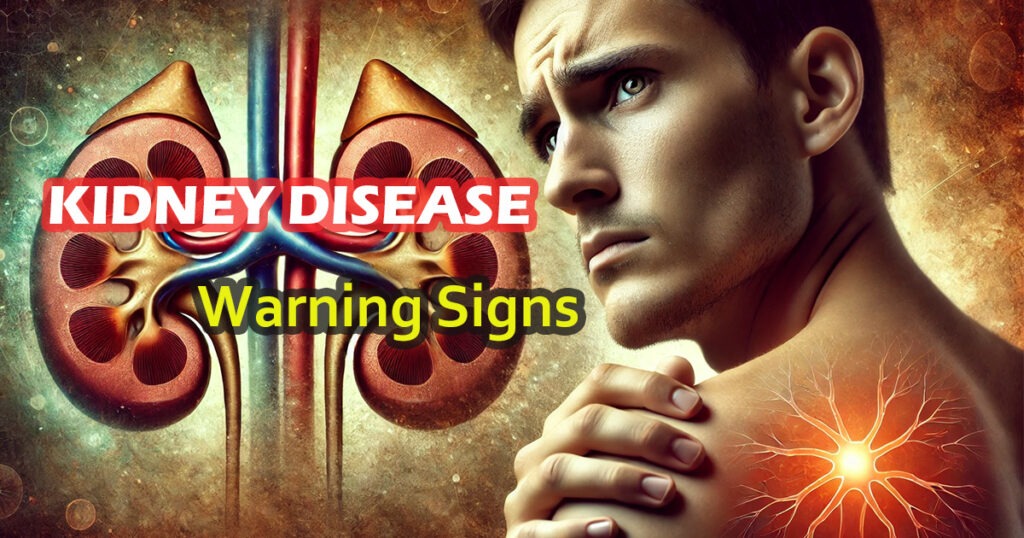How To Identify Early Signs of Kidney Disease

In this article, we will delve into the crucial functions of your kidneys and equip you with the knowledge to identify signs of potential damage.
Acting as a sophisticated filter system within the human body, the kidneys are a matched pair of bean-shaped organs located below the ribs on either side of the spine. Their primary function involves filtering waste from the blood and producing urine. They also play a crucial role in maintaining your body’s acid-base balance by removing cellular acid waste and maintaining a balanced composition of water, salts, and minerals like sodium, calcium, phosphorus, and potassium in the bloodstream, which is crucial for maintaining proper bodily functions. Without this balance, your body’s nerves, muscles, and other tissues may not work normally.
Kidneys also release hormones that help: control blood pressure, stimulate the bone marrow to produce red blood cells, keep your bones strong and healthy, and help the colon absorb calcium.
Healthy kidneys filter about half a cup of blood every minute, removing waste and extra water to create urine. The urine then flows from the kidneys to the bladder through two muscular tubes called ureters, one on each side of the bladder, which stores the urine until it’s eliminated from the body.
The Remarkable Structure of the Kidneys
The human body has two Kidneys. Each bean-shaped organ is about the size of a fist and can weigh approximately—on average—137 grams in males and 118 grams in female adults. Generally, the left kidney is slightly larger than the right in males and females. Interestingly, the human body can function effectively with just one kidney because a single kidney can filter all of the body’s blood.
Kidneys are composed of solid tissue known as parenchyma, consisting of two main parts: the renal cortex and the renal medulla:
Renal cortex
The kidney’s outer layer has a grainy texture and contains about 1.2 million renal corpuscles, where urine is produced. The cortex also contains glomeruli (filters), convoluted tubules, and blood vessels.
Renal medulla
This inner part of the kidney has a smoother texture and contains blood vessels and winding renal tubules. The medulla also contains collecting tubules (for urine) and loops of Henle, which are U-shaped parts of the collecting tubules.
Kidney capsule (renal capsule)
Three layers of fat or connective tissue cover the kidneys, providing stability, protection, and attachment to surrounding tissue.
Nephrons
About a million filtering units, each includes a glomerulus (filter) and a tubule.
Renal papilla
Pyramid-shaped structures that transfer urine to the ureters.
Renal pelvis
A funnel-shaped structure that collects urine and passes it down two ureters.
It is essential to note that Kidney function declines with age, and injury or disease can damage them. Kidney damage can lead to kidney disease, also known as renal disease. Early detection of kidney disease can be lifesaving.
Did You Know?
According to the US Centers for Disease Control and Prevention (CDC):
- Approximately 35.5 million adults in the US, which is about 1 in 7, are estimated to have chronic kidney disease (CKD).
- 9 out of 10 adults don’t even know they have CKD.

Early Detection of Kidney Disease
Preventing kidney disease is ideal, but as we all know, things happen. Accordingly, the next best thing to prevention is early detection because detection of kidney disease can help prevent and manage chronic kidney disease. A doctor can perform regular blood and urine tests to check for kidney disease. These blood tests can measure how well the kidneys filter blood, while urine tests can check for albumin, a protein that can pass into urine when the kidneys are damaged. Some symptoms of kidney disease include:
- Changes in urine frequency or quantity, especially at night
- Blood in urine
- Foamy urine
- Puffiness around the ankles and legs
- Weight loss and poor appetite
- Shortness of breath
- Tiredness
- Difficulty sleeping
- Itchy skin
However, many people with chronic kidney disease (CKD) don’t have symptoms until the disease is more advanced or complications develop. Symptoms can also manifest in other disorders, so scheduling an appointment with a doctor is crucial if anything is problematic.
People who have more advanced stages of CKD may also notice:
- Trouble concentrating
- Numbness or swelling in your arms, legs, ankles, or feet
- Achy muscles or cramping
- Vomiting
- Breath smells like ammonia (also described as urine-like or “fishy”)
Causes of Kidney Disease
According to the American Kidney Fund, the two most common causes of chronic kidney disease are diabetes and high blood pressure. Diabetes indicates elevated blood sugar levels, leading to kidney damage because the blood vessels inside the kidneys become narrowed over time by high sugar concentration. High blood pressure, or hypertension, occurs when the force of blood against the artery walls is too high, potentially leading to damage and increasing the risk of chronic kidney disease. Other kidney problems with the kidney that can lead to chronic kidney disease include:
Glomerulonephritis– is a group of kidney diseases that damage the glomeruli, the tiny filter units in the kidneys that filter blood. This damage can occur quickly or over time and can be caused by the immune system attacking healthy tissue. When the glomeruli are damaged, they can’t properly filter toxins, metabolic wastes, and excess fluid into urine, causing them to build up in the body. This can lead to swelling, fatigue, and other symptoms:
- Dark brown urine from blood and protein
- Decreased urine output
- High blood pressure
- Swelling in the face and ankles
- Frequent urination at night
- Bubbly or foamy urine from excess protein
- Abdominal pain
- Frequent nosebleeds
Polycystic kidney disease (PKD)– is a genetic condition that causes the growth of fluid-filled cysts (sacs) in the kidneys. The cysts can vary and grow very large, causing the kidneys to enlarge and lose function over time.
PKD may be inherited through families but can also develop as a spontaneous mutation. People with PKD1 mutations tend to have a more severe form of the disease than those with PKD2 mutations, and symptoms may appear later in adulthood. PKD may not have any symptoms until it’s well advanced, but it can cause other health problems, including:
- High blood pressure
- Kidney pain
- Kidney failure
- Urinary tract infections (UTIs)
- Kidney stones
- Heart problems
- Colon problems
- Brain aneurysms
- Preeclampsia during pregnancy
Lupus nephritis– According to the Institute of Health, Lupus nephritis, also known as lupus kidney disease, is a kidney disorder that occurs when systemic lupus erythematosus (SLE) causes kidney inflammation. SLE is an autoimmune disease that causes the body’s immune system to attack healthy cells and tissues. In lupus nephritis, autoantibodies from lupus affect the parts of the kidneys that filter waste, causing swelling and irritation. This can damage the kidneys, making it difficult for them to remove waste from the blood or regulate fluid levels.
Symptoms of lupus nephritis include:
- Blood or protein in the urine
- Foamy urine, also known as proteinuria
- Swelling in the face, hands, feet, belly, or around the eyes
- Weight changes, usually weight gain but sometimes weight loss
- Feeling very tired
- Urinating less often than normal
- High blood pressure
Lupus nephritis can lead to other disorders, such as interstitial nephritis, nephrotic syndrome, membranous glomerulonephritis, and kidney failure. Kidney inflammation can be a sign of severe illness that requires aggressive treatment.
The exact causes of a misfiring immune system are not fully understood, but suspected factors include infections, hormones, certain medications, and genetic factors.
Kidney Cancer– A disease that occurs when cells in the kidney grow and divide abnormally, forming tumors. It can affect either kidney, but usually only one is affected. There are many different types of kidney cancer, including:
Types of Kidney Cancer
Renal cell carcinoma (RCC)
The most common type of kidney cancer in adults, accounting for about 90% of cases. RCC forms in the lining of the kidney’s tiny tubes that return filtered substances to the blood and remove waste as urine. Smoking and misuse of certain pain medicines may increase the risk of RCC. Signs of RCC include blood in the urine and a lump in the abdomen.
Transitional cell carcinoma (TCC)
Also known as urothelial carcinoma, this form of kidney cancer can originate in the ureter or renal pelvis, where the kidney and ureter meet. It is typically treated similarly to bladder cancer.
Wilms tumor
Also known as nephroblastoma, this is a rare type of kidney cancer most common to manifest as a renal tumor in children.
Factors That Can Affect the Prognosis and Treatment Options for Kidney Cancer
When it comes to kidney cancer, the road to recovery can be shaped by several critical factors. The extent of the cancer’s spread, the speed at which it has advanced, and the specific type of kidney cell it originates from all play pivotal roles. Moreover, the degree to which these cancerous cells resemble normal ones can significantly impact treatment options and outcomes. Understanding these factors not only empowers patients and caregivers but also highlights the importance of early detection and personalized treatment plans in the fight against kidney cancer.
Summing Things Up
In this article, we have discussed the structure and essential functions of kidneys and the signs of early kidney disease. If you are displaying any of these symptoms, make sure you see your primary care doctor immediately. If you want to learn more about prevention and natural ways to reverse kidney disease, please check out my next article. Until then, take care of yourselves. Happy healing. See you soon, and God bless.
Related Links
Boosting Your Health with Antioxidants: What You Need to Know
